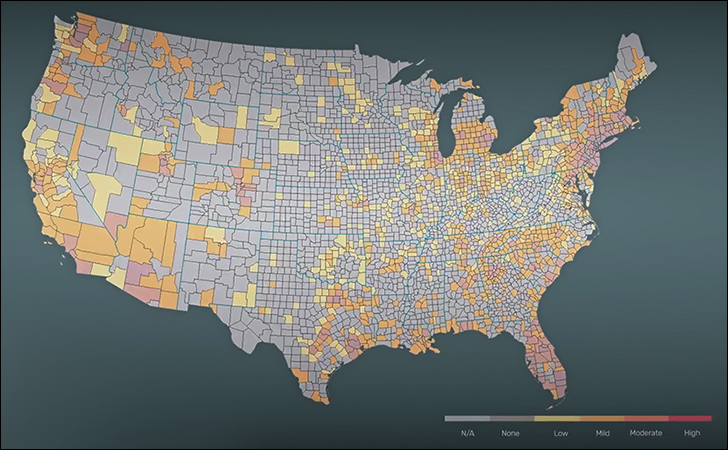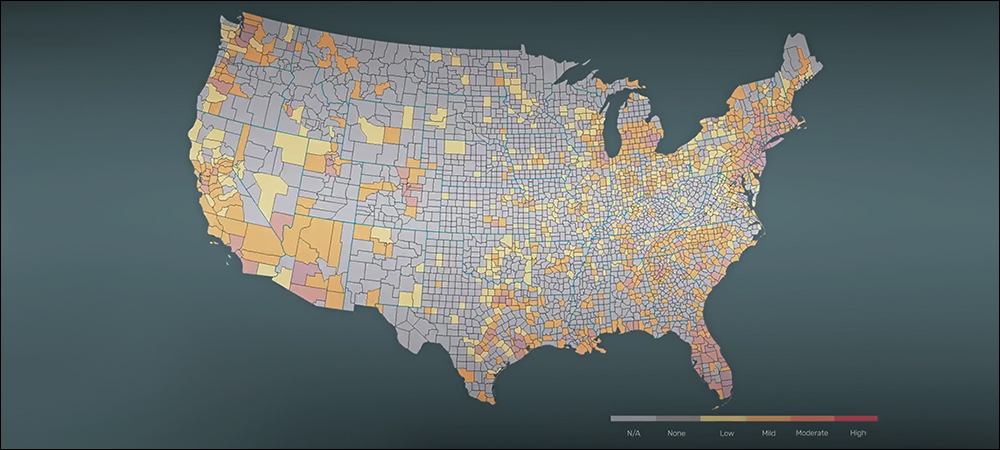- Making Predictions that Outpace the CDC
- How the System Works
- Taking Data to Brands and Healthcare Companies
Digital healthcare technology company Kinsa has released a solution called Kinsa Insights that enables companies to use aggregated data related to health conditions around the United States to market or direct products to the appropriate location, or to help hospitals prepare for increased patient load. The resultant infection transmission predictions are derived from Bluetooth Low Energy (BLE)-based data from Kinsa’s wireless thermometers, used by individuals in their homes, as well as from other app-based information.
Kinsa’s thermometer and app were released in 2014, and multiple versions of the solution are now being sold by retailers across the United States. Since its release, the company has collected, managed and analyzed data. After many years of studying the information and ensuring its predictive integrity, the firm has released Kinsa Insights.

The Kinsa Insights solution provides infection transmission predictions around the United States.
The solution is available commercially for consumer packaged goods (CPG) and healthcare companies, as well as other enterprises looking to access information about health conditions in their area. By understanding where illnesses are spreading, and with projections about the future health of a specific area’s population, hospitals can better prepare to serve those in need, Kinsa reports, while CPG brands and retailers can use the trends to better stock their shelves with relevant products.
While Kinsa had initially provided its analytics as a custom service to public health entities and health organizations, its focus has more recently been on CPG companies. Some brands have already been using the solution, which links the thermometer data and analytics, and provides predictions for regions of the country.
Making Predictions that Outpace the CDC
Brands using the data can direct inventory to their retailers in a given region and thus avoid shortages, says Nita Nehru, Kinsa’s VP of communications. So far, she claims, the solution has been beating the Centers for Disease Control and Prevention (CDC) in publicly identifying where illnesses will surge, by about two to three weeks.

Nita Nehru
The company’s founder and CEO, Inder Singh, has a history in public health, having served as the executive VP of the Clinton Foundation’s Clinton Health Access Initiative (CHAI). He was frustrated by the way in which funding is allocated to stop the spread of infectious illness, Nehru says, as well as by the allocation of products and services focused on preventing or stopping the spread of infectious illness. Too often, Singh found, there wasn’t enough real-time information available related to where symptoms were starting or how fast they were spreading.
It was with that problem in mind, Nehru says, that Singh set out to find a way to capture unique data “that the healthcare system misses entirely—he had a mission to create a real-time map of human health.” His new company, Kinsa, created a thermometer connected to an app, which could benefit users by providing their temperature and related practical advice, but also could collect community-wide data. The company chose the thermometer as its data-collection product, Nehru says, because a thermometer is often the first and only device individuals turn to in their home to confirm an illness.
The early version of the smart thermometer could be plugged directly into a smartphone’s headphone jack, so that the app could capture temperature information. In 2017, Kinsa released a Bluetooth-enabled version of its thermometer, once the headphone jack was discontinued in some smartphones. With the product now in use by 2.5 million households, the company has been aggregating data captured by the app about consumer health, as well as collecting weather conditions and other regional factors. That information is linked to each thermometer reading, and the system can thus detect trends and predict outbreaks related to various illnesses.
How the System Works
Individuals who buy the product first download the corresponding Kinsa app for their Android- or iOS-based devices. Next, they set their user profile. Multiple family members can be associated with the app and thermometer. While the thermometer simply takes temperatures, the app provides information based on the results, or on symptoms input by users when they aren’t feeling well. The system can leverage data regarding an individual’s age, gender and health conditions. The company likens the app to “a nurse in your pocket, helping your family and your community get better faster.”

Inder Singh
Individuals may be asked a series of questions about symptom severity, after which the system provides personalized guidance about reducing symptoms, as well as when to seek medical care and other information. Users can view such information as any infections that might be spreading at their child’s school or in their local area. Those leveraging the app do not need to use the thermometer. If they feel unwell, they can deploy the app for recommendations based on their symptoms. Kinsa Insights collects anonymous data about temperature measurements, and regarding symptoms being reported through the app.
Throughout the past five to seven years, the company has been building artificial intelligence and machine learning insights to determine how well it can predict illness. This data is now being employed by brands that are subject to illness-driven demand, with products ranging from flu and cold medicines to disinfectants. The company’s demand-forecasting solution, Nehru says, allows brands and retailers to answer the question, ‘Where do I need to have how much stock, so that I can get consumers the medications they need?”
Some healthcare companies are using the collected data to better forecast how much bed capacity and staff they will need to have on hand to meet a demand, such as a local flu surge. The data also provides value for health insurers, the company explains, since they can better direct proactive messaging to members to make sure they stay out of the hospital.
Taking Data to Brands and Healthcare Companies
That represents a different approach to infection management, according to Matthew Bolden, Kinsa’s senior product-marketing director. “We’re capturing what is real biometric data from folks before they get into the healthcare system,” he states. The solution features the company’s Inside Explorer Platform, Bolden says. The analyses are aided by a team of epidemiologist, he adds, who provide regular updates for a particular region. The solution can create illness forecasts for 30 different symptoms and categories, he explains.

Matthew Bolden
While Kinsa has been providing such forecasting for a number of years, the company is only now commercially releasing the platform, after having compiled enough data and testing of its tracking and forecasting accuracy through several flu seasons. CPG companies can use the data, for instance, to view that flu symptoms are on the rise and predicted to increase in one state, while declining in another. They could then shift product to a distribution center in a surge area. Retailers could also use the data to re-route products from one store to another.
Although the technology was in use before the COVID-19 outbreak, Nehru says, the data has helped to highlight the need for infectious disease predictions. “Our mission has always been to help stop the spread of infectious illness,” she states, “and when COVID came on the scene, what was really unique was that we could tell something unusual was happening across the country,” early into the outbreak.
In past years, Nehru says, Kinsa had focused on providing its data and analytics to public health agencies, as well as to local and state governments. “We felt like that was the right thing to do,” she explains, “and we would be able to help.” However, the company is now directing its solution toward commercial brands, retailers and hospitals. The players able to act on this information, she adds, are more likely to be businesses, such as brands and pharmacy chains, than public health organizations. “In the last year or so, we pivoted to focusing a lot more on the brands and retailers, and on reducing our emphasis on working with public health.”
To date, Kinsa reports, its solution has proven to reduce forecasting errors—incorrect predictions of disease trends—by 50 percent. Companies already using the system include Mucinex, which employs Kinsa’s two-week cough, cold and flu forecast, and Johnson & Johnson Consumer Health (JJCH), which is using the technology to build out long-term supply capacity and make better financial planning decisions.
Key Takeaways:
- BLE-based thermometer data is providing data to Kinsa’s solution to help brands, retailers and healthcare companies predict infectious disease spread in communities.
- Products that aid in disease prevention and recovery can be better routed where they’re needed, which boosts sales and better serves those who are ill.


